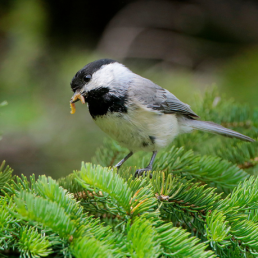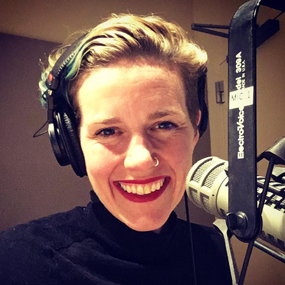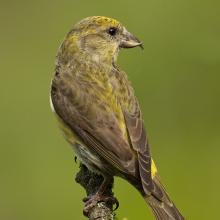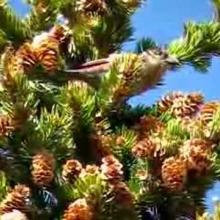

Join BirdNote tomorrow, November 30th!
Illustrator David Sibley and actor H. Jon Benjamin will face off in the bird illustration battle of the century during BirdNote's Year-end Celebration and Auction!
A young crossbill starts life with a wedge-shaped beak. As it grows up and starts to feed itself by removing conifer seeds from their tough packaging, the tips of its bill begin to grow rapidly — and then they cross. By the time the bird is a month and a half old, the tips of its bill become fully crossed.
BirdNote®
When Does a Crossbill’s Bill Cross?
Written by Bob Sundstrom
This is BirdNote.
[Red Crossbill calling]
If you were to look at the beak of a baby loon or young crossbill, you’d have to wonder just what kind of bird you were seeing. Because their beaks look nothing like the beaks of their parents.
Red Crossbills are a striking example of how some young birds must grow into their adult bill shape.
[Red Crossbill type #2 calling]
A young crossbill starts life with a wedge-shaped beak. As it grows up and starts to feed itself by removing conifer seeds from their tough packaging, the tips of its bill begin to grow rapidly — and then they cross.
[Red Crossbill type #2 calling]
By the time the bird is a month and a half old, it’s been twisting its bill again and again, always in the same direction, as it extracts hard-to-get seeds. The tips of its bill become fully crossed — kind of like when your parents warned you that if you keep making that face, it’s going to stick that way.
[Common Loon call]
And take loons. These birds begin life with stubby bills that slowly develop their full dagger shape.
Or flamingos. A baby flamingo has a beak that looks more like that of a goose. But as the bird grows, the beak starts to curve into that strangely bent flamingo beak we all recognize.
Despite some awkward teenage phases, all of these young birds eventually grow into — and come to rely on — their unique beaks.
[Common Loon call]
For BirdNote, I’m Ashley Ahearn.
###
Producer: John Kessler
Executive Producer: Sallie Bodie
Editor: Ashley Ahearn
Associate Producer: Ellen Blackstone
Assistant Producer: Mark Bramhill
Bird sounds provided by The Macaulay Library of Natural Sounds at the Cornell Lab of Ornithology, Ithaca, New York. Red Crossbill ML82851841 recorded by G Chapman, 0:05 - 0:55. Common Loon ML116589201 recorded by D Everaert 0:55 - end.
BirdNote’s theme was composed and played by Nancy Rumbel and John Kessler.
© 2020 BirdNote February 2020/2022
ID# RECR-02-2020-02-11 RECR-02 Narrator: Ashley Ahearn
[some background on crossbill beaks] https://judyhoy.com/f/red-crossbills
https://www.summitdaily.com/news/summit-outside-the-unique-beak-of-the-…





